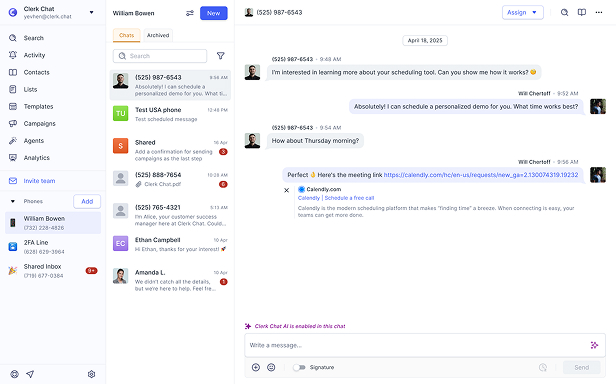The Best AI Voice Agents: Platforms, Use Cases, and Trends
By William Bowen
- Published: October 3, 2025
Calling a business should be simple. But you already know how it usually goes. You wait on hold. You get transferred around. You repeat the same problem three different times. By the time you finally land on the right person, that small task has eaten half your afternoon.
That’s the gap between what people need and what companies manage to deliver. It’s also where the best AI voice agents are starting to make a difference. These systems don’t just “answer the phone.” They listen, understand the request, and act on it, booking an appointment, pulling account info, or passing you straight to the right team.
These aren’t fringe tools anymore. The global market for voice AI agents was worth about $2.4 billion in 2024. By 2034, it’s on track to hit nearly $47.5 billion, growing faster than just about any other corner of AI.
The tough part now isn’t whether to use one, but which one to pick. There are dozens of AI voice companies offering natural conversations, smooth integrations, and better results. Some are light enough for a small business to set up in a day. Others are built for enterprises handling millions of calls across multiple languages. A few are developer-first frameworks you can bend into any shape you want. The question is less about possibility and more about fit.
In this article:
Understanding the Value of AI Voice Agents
A voice agent sounds like a fancy idea, but it’s really simple. It’s software that listens to what someone says, figures out what they mean, and replies on the spot. What makes it different from those old “press one for sales” menus is the tech under the hood: speech recognition, intent recognition, and natural language processing (NLP) working together.
Instead of pressing buttons or repeating yourself three times, you can just talk, and the system figures out what to do next. Essentially, it’s the next level of AI in customer service – not just chatbots, but systems that can speak and listen to people, just like other human agents.
Voice AI platforms can have an impact on every part of the customer journey, across industries. A clinic can use a no-code platform to set up reminders, so patients don’t miss appointments. Sales teams lean on agents for lead qualification, asking the right questions and routing the hottest prospects. In the front office, these tools answer everyday questions or transfer calls smoothly.
In the back office, they can act as AI scribes, capturing notes and creating summaries so staff don’t spend hours typing. Elsewhere, companies even use AI voice interviewers to screen candidates, giving hiring managers more time to focus on the people who make it to the final stage.
Scan any of the new voice agent market maps and the trend is obvious: AI voice companies are moving quickly, building tools for everything from support automation to highly regulated industries. The best AI voice agents are here to take care of the repetitive tasks, keep systems updated, and make sure customers feel heard, while human teams focus on the conversations that matter most.
The Use Cases for Voice AI Platforms and Agents
The strength of the best AI voice agents isn’t in the tech itself; it’s in how they fit into the work people are already doing. Companies in every sector are finding new applications for these tools every day, across sales, marketing, customer service, employee experience and more:
- Customer Support & Service: AI tools for support teams are gaining ground. A voice agent can pick up routine questions, open or update support tickets, and route calls to the right place. That means shorter waits and less frustration.
- Sales and Lead Handling: For inbound and outbound sales calls, agents can run quick lead qualification checks. A few smart questions, then the warm leads go straight to a rep.
- Healthcare-Focused Use Cases: With the top AI agents for healthcare, clinics handle the basics- booking appointments, reminding patients about prescriptions, or checking in after a visit. No-show rates and missed payments drop.
- Recruitment and HR: AI voice interviewers handle the first round of screening. Every applicant gets heard, and recruiters get hours back in their week.
- Training and Coaching: Using simulators, staff can practice conversations in a safe space. These training use cases help build confidence before anyone talks to a real customer.
- Client Onboarding: New customers can walk through setup step by step with an agent guiding the way. That smooth start builds stronger customer relationships and reduces churn.
Modern AI voice companies are no longer offering one-off tools. They’re creating flexible platforms that adapt to everyday business challenges, across every department and function.
Comparing the Best Voice AI Agents: What to Consider
All of the well-known voice AI platforms promise the same stuff. They all say they revolutionize call center customer service, and make it easy to set-up custom workflows. But when you actually put them to work, big differences appear. Some stumble on accents. Some can’t handle interruptions. Some sound natural, others robotic.
Here are the factors that really matter when choosing the best AI voice agents:
- Voice quality & realism: The best voice AI systems don’t just talk, they sound alive. With tools like emotional vectors, agents can shift tone - calm during a support call, warmer in a sales follow-up, or steady when giving technical instructions. They should also handle different languages and accents without missing a beat.
- Performance in real-world scenarios: Demos look perfect because they’re scripted. Real calls aren’t. The real test is what happens when someone interrupts, changes their mind, or hesitates mid-sentence. The strongest agents adapt without breaking stride.
- Seamless integrations: A good agent plugs right into CRMs like Salesforce, plus help desks or calendars. If it doesn’t, people end up re-entering the same details twice and at that point, the benefit disappears.
- Customization and scalability: A small practice might only need a simple no-code setup. A large company might need complex routing in different languages. The better AI voice companies let you start small and grow without swapping platforms later.
- Data security and compliance: In healthcare, finance, and similar fields, there’s no room for shortcuts. If call summaries or records aren’t handled properly, it’s a problem. Vendors should be able to show proof of HIPAA, GDPR, and SOC2 compliance.
- Reliability and support: A voice ai platform that drops calls during busy hours does more damage than good. You want a service with strong uptime and a support team you can actually get hold of when things break.
- Transparent costs: Some providers bill by the call, others by the minute, others by subscription. Make sure you know which before you sign up, because hidden fees can sink a rollout fast.
Don’t just read feature lists from AI voice companies. Put each platform through the situations that matter most for your business. That’s when you’ll see which ones are truly reliable, and which ones only shine in demos.
The Best AI Voice Agents in 2025: Comparing Platforms
With so many AI voice companies launching products, it can feel impossible to know where to start. Some voice AI platforms are built for small teams who just want quick automation. Others are engineered for enterprises running millions of calls. A few are developer-first frameworks that let you control every detail.
Rather than just list features, we’ve looked at how these tools perform in practice, how they sound, how easily they integrate, and whether they actually make work easier.
1. Clerk Chat: Best for Omnichannel Conversations
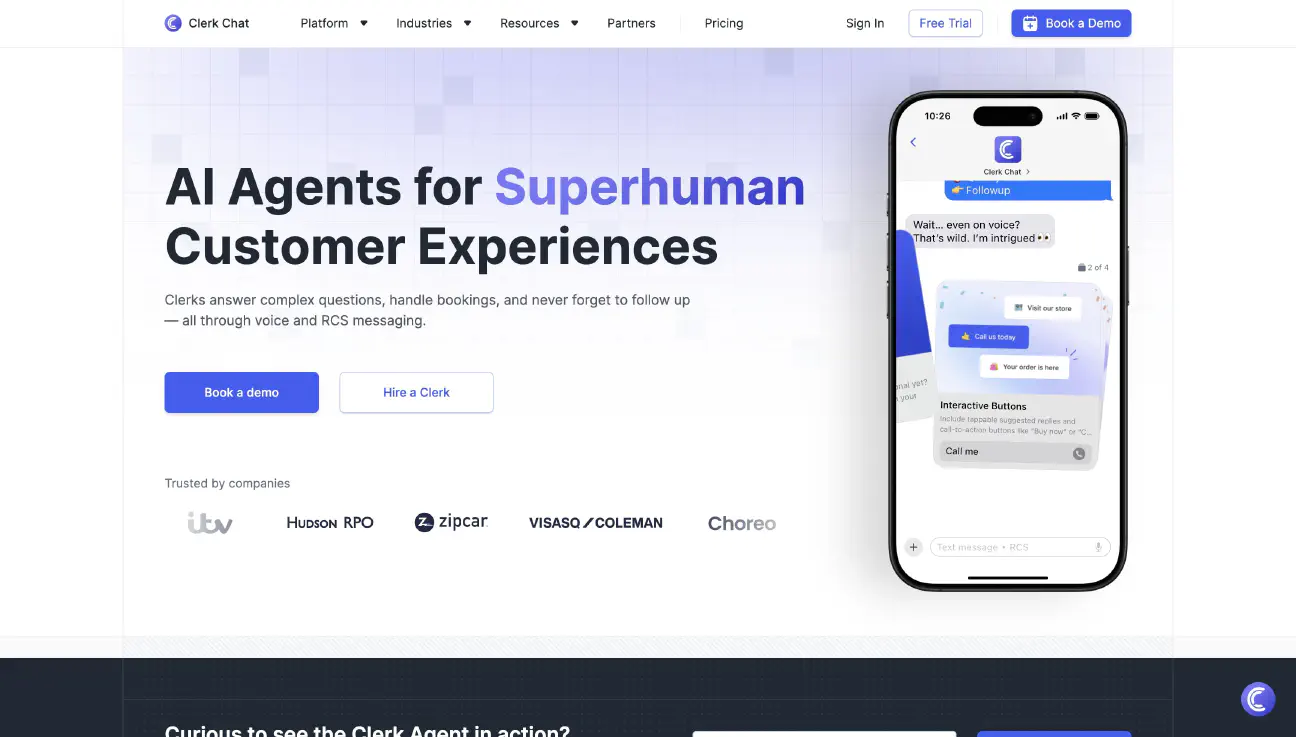
Most voice agents focus only on phone calls. That works for some businesses, but the truth is that customers reach out in all kinds of ways - WhatsApp, SMS, RCS, or email. That’s where Clerk Chat stands out. It doesn’t silo communication; it pulls everything into one place.
A customer sends a text to your business number, another writes on WhatsApp, and a third calls in. Instead of juggling three platforms, Clerk Chat routes it all into a single interface. Your team, or your AI agent, can answer or reply instantly, without losing track of context.
Clerk Chat’s AI is designed to go beyond answering questions. You can build fully customizable agents that book appointments, qualify leads, update your CRM, or manage end-to-end two-way customer communications. It’s flexible enough for a small team to set up quickly, with a simple AI-powered messaging tool, or voice agent for Microsoft Teams. But it also scales, opening the door to agentic AI capabilities for enterprises.
Key Features
- Unified inbox across voice, SMS, WhatsApp, RCS, and more
- Customizable voice AI platform
- Deep CRM and workflow integrations
- Built-in scheduling and reminders
- Strong track record reducing support tickets and improving customer relationships
Pricing: Starts at $19.99/month (Ultimate tier) with 5,000 contacts and unlimited messages. Costs scale with usage.
Pros
- True omnichannel approach (not just voice)
- Strong CRM integrations and automation
- Proven impact on reducing manual workload
- Options for both conversational messaging and agentic AI
Cons
- Some setup effort required for full customization
- Lowest pricing tier lacks AI features
2. Lindy: Best for No-Code Voice Agent Setup
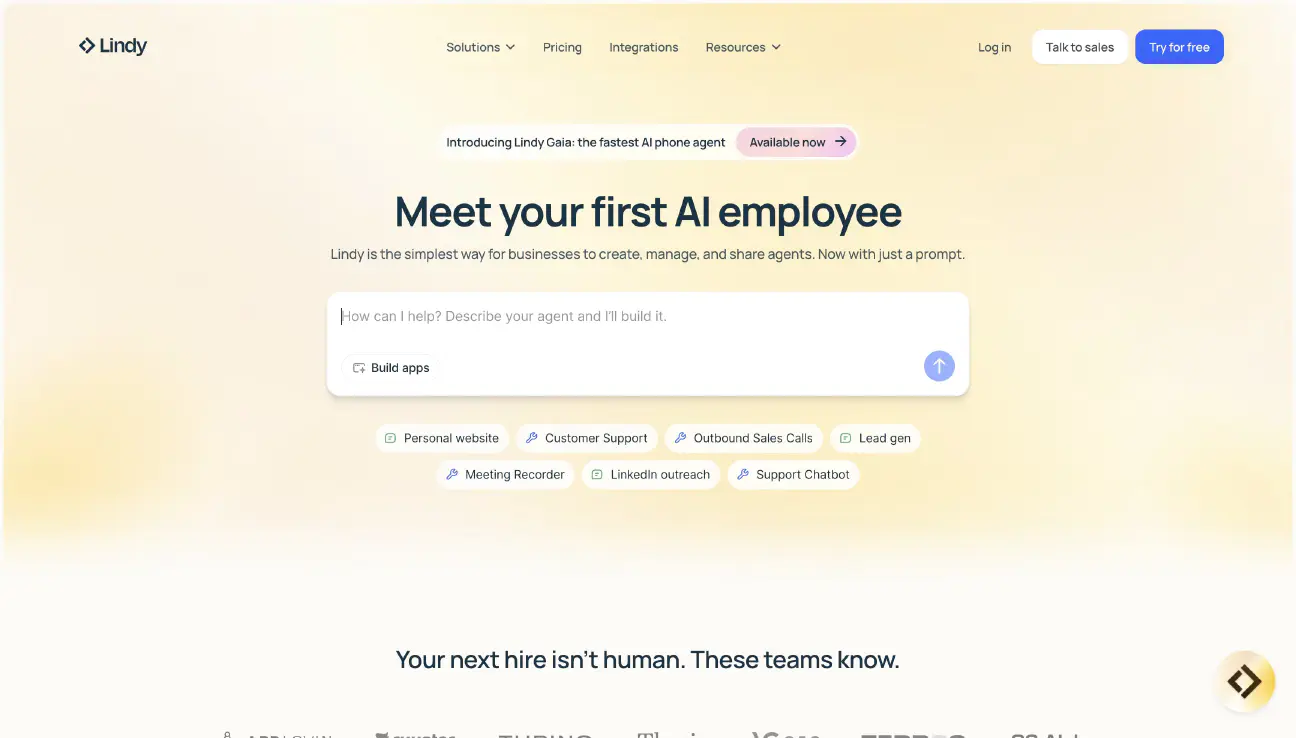
Not every team has developers on standby. Many just want something that works out of the box. That’s what makes Lindy so compelling, if you want to dive into voice AI features fast. It’s one of the few voice AI platforms built for non-technical teams who still need powerful automation.
With Lindy, you can create an agents that pick up a call, has a natural back-and-forth, and then does something with the information. If someone calls about a support issue, Lindy answers, checks your knowledge base, resolves the problem, and logs the conversation automatically.
Because it’s a no-code platform, you can drag and drop the flow yourself. Want it to qualify leads? Add a few questions. Need it to schedule follow-ups? Link it to your calendar. It’s fast, and you don’t need IT to get involved.
Key Features
- Natural-sounding conversations for inbound and outbound calls
- No-code drag-and-drop flow builder
- Built-in call summaries and Slack/CRM updates
- Runs multiple calls simultaneously
- Integrates with knowledge bases and databases
Pricing: There’s a free plan (limited features), then a few tier options: Pro: $49.99/month, includes call automation. Business: $299.99/month, higher limits and premium support
Pros
- True no-code setup for non-technical teams
- Handles real phone calls, not just chat-like scripts
- Summaries and follow-ups included out of the box
- Scales across support, sales, and client onboarding
Cons
- Call features locked behind paid tiers
- Requires a dedicated phone number for some functions
3. Vapi: Best for Developer Control and Customization
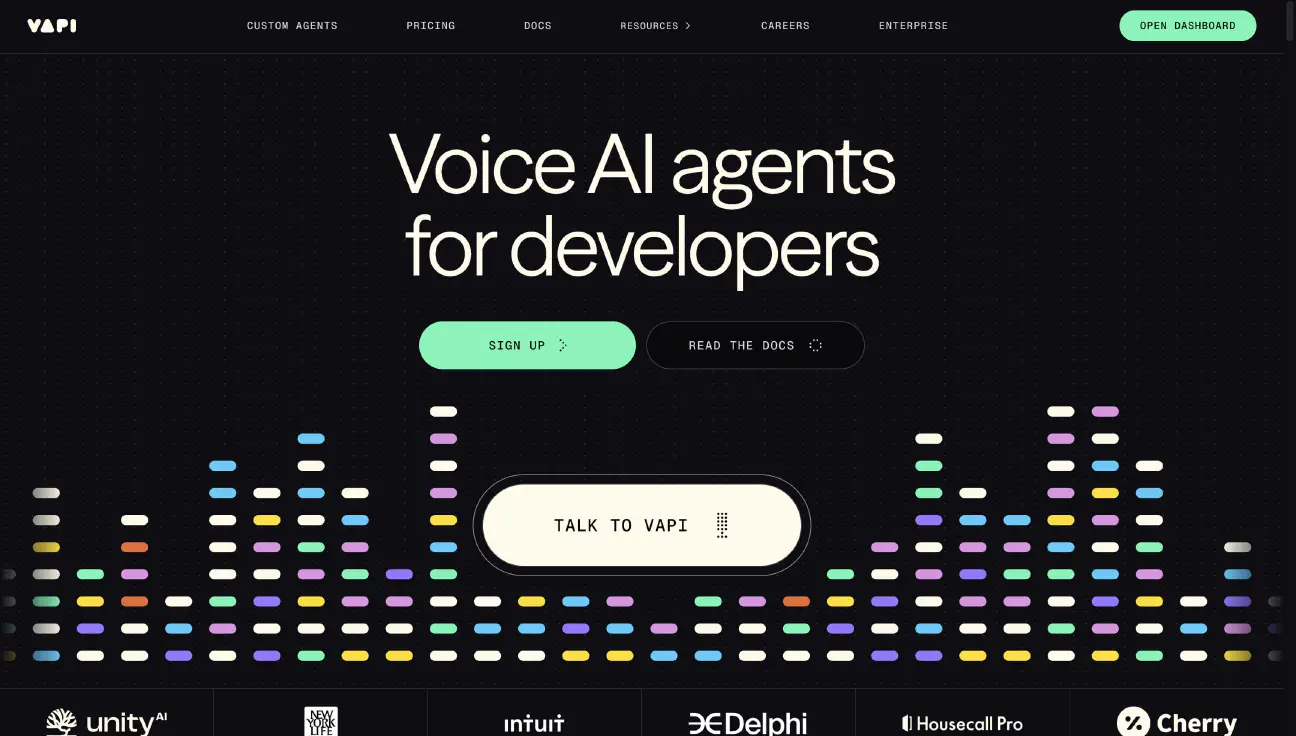
While some teams want no-code tools, others need complete flexibility. Vapi is for that second group. It’s an API-first voice AI platform that gives developers full control to build exactly what they want.
What sets Vapi apart is speed. In testing, responses come back almost instantly - with latency low enough that conversations feel seamless. Developers can plug in their own transcription models, voices, and large language models. That means you’re not locked into one provider.
A common use case: building an agent using AI for financial services that verifies a caller’s details, checks them against a database, and triggers a backend process, all in real time. With Vapi, that’s straightforward if you’re comfortable working with APIs. It’s not for beginners, but in the right hands it’s one of the most flexible systems for voice agents available.
Key Features
- API-first, developer-focused architecture
- Plug-and-play with multiple models (speech recognition, voices, LLMs)
- Real-time call handling with very low latency
- Scales to thousands of concurrent calls
- Full control over call logic and workflows
Pricing: The free trial gives you $10 credits. Alternatively, usage-based pricing starts at $0.05/minute (billed per second). You’ll also pay $2/month per phone number, and extra fees for external models.
Pros
- Deep customization and flexibility
- Extremely low latency in real-world scenarios
- Scales easily for high call volumes
- Works cleanly with modern stacks
Cons
- Requires coding knowledge (not beginner-friendly)
- Costs can add up quickly with heavy use
4. Bland AI: Best for Custom Voice Generation
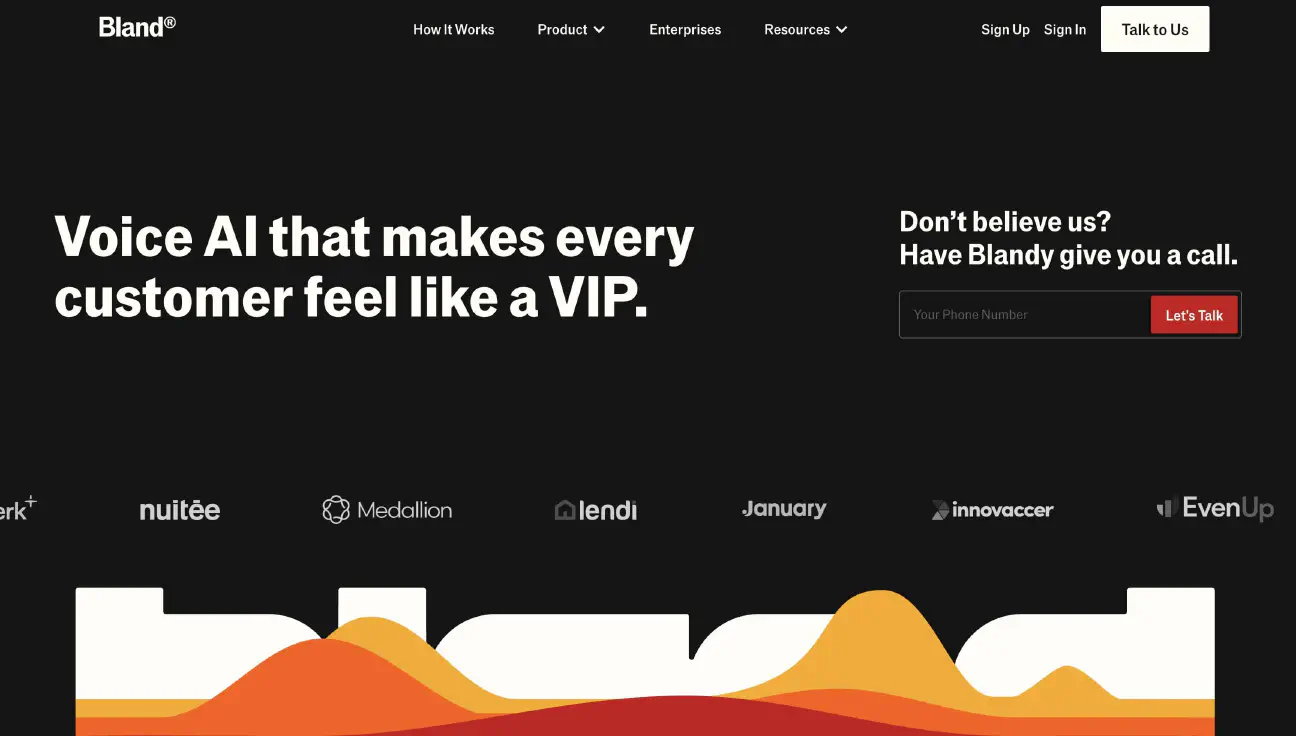
If you’re looking for the best AI voice agents that sound genuinely human, Bland is a good choice. Unlike platforms focused on workflows, Bland specializes in voice itself, letting you generate custom tones, accents, and even emotional inflections.
With Bland you can pick from a range of styles, accents, and tones. That might be a cheerful voice for onboarding, a steady one for technical walkthroughs, or something warmer in a healthcare setting. Even small shifts, like a slight lift in tone at the end of a question, help conversations feel more natural.
Bland doesn’t manage call routing or conversation flows. Instead, it slots into your stack via API. That means it works best when paired with another Voice AI platform, or system for conversational customer engagement.
Key Features
- Wide range of customizable voice styles and accents
- Emotional inflection for natural delivery
- API-first integration for existing workflows
- Enterprise-ready for large-scale deployment
- Works well across customer service, IVR, and training simulators
Pricing: There’s a free trial available, after that, you’ll need a custom quote, which is why some companies end up switching to Bland AI alternatives (for more pricing clarity).
Pros
- Some of the most natural and expressive voices on the market
- Huge variety of accents and tones
- Scales easily for enterprise use
- Fits neatly into existing systems
Cons
- Doesn’t handle conversation logic or routing
- Pricing requires contacting sales (no public tiers)
5. Synthflow: Best for Fast Deployment
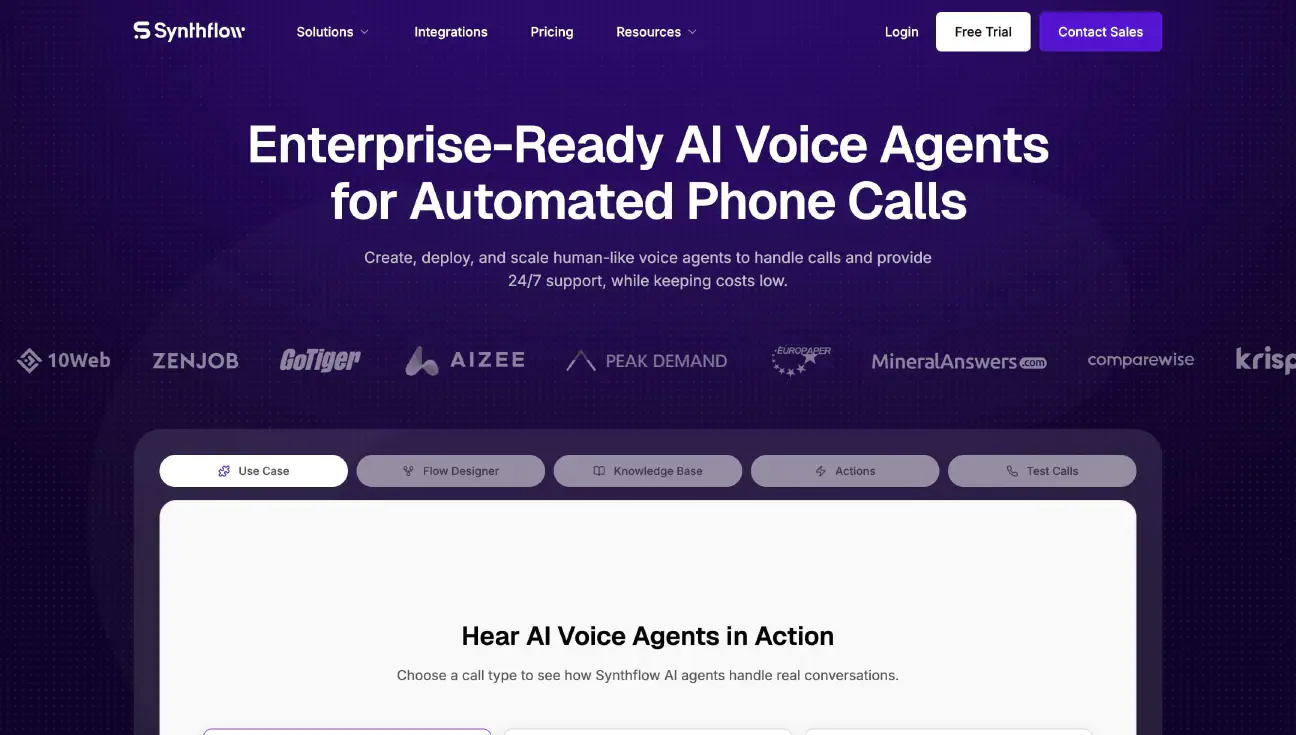
Sometimes speed is everything when you’re looking for the best AI voice agents. You don’t want a six-week setup or a developer on call; you want something live tomorrow. That’s where Synthflow fits in. It’s a voice AI platform designed to get a working agent off the ground in hours.
The no-code builder is surprisingly intuitive. You drag out conversation blocks, set up responses, and link them to your CRM or calendar. We had no problem creating a simple lead qualification flow, connecting it to HubSpot, and start taking calls in less than a day.
One of Synthflow’s best features is the visibility it gives you. Every call is automatically logged, transcribed, and broken down. You can track where callers hung up, how many booked appointments, or when an agent ran into trouble.
Key Features
- No-code conversation builder
- Real-time analytics and call transcripts
- Integrations with CRMs, helpdesks, and scheduling tools
- Handles inbound and outbound calls
- Natural conversation flows with fallback options
Pricing: Plans start at $29 per month for 50 minutes of calling, or $450 per month for 2,000 minutes of AI calling, and scale from there.
Pros
- Very fast to set up and test
- Strong analytics and insights
- Easy to integrate with existing tools
- No coding required
Cons
- Price jump is massive between starter and business tiers
- Less flexible than developer-first tools like Vapi
6. Retell AI: Best for Post-Call Analysis and Healthcare
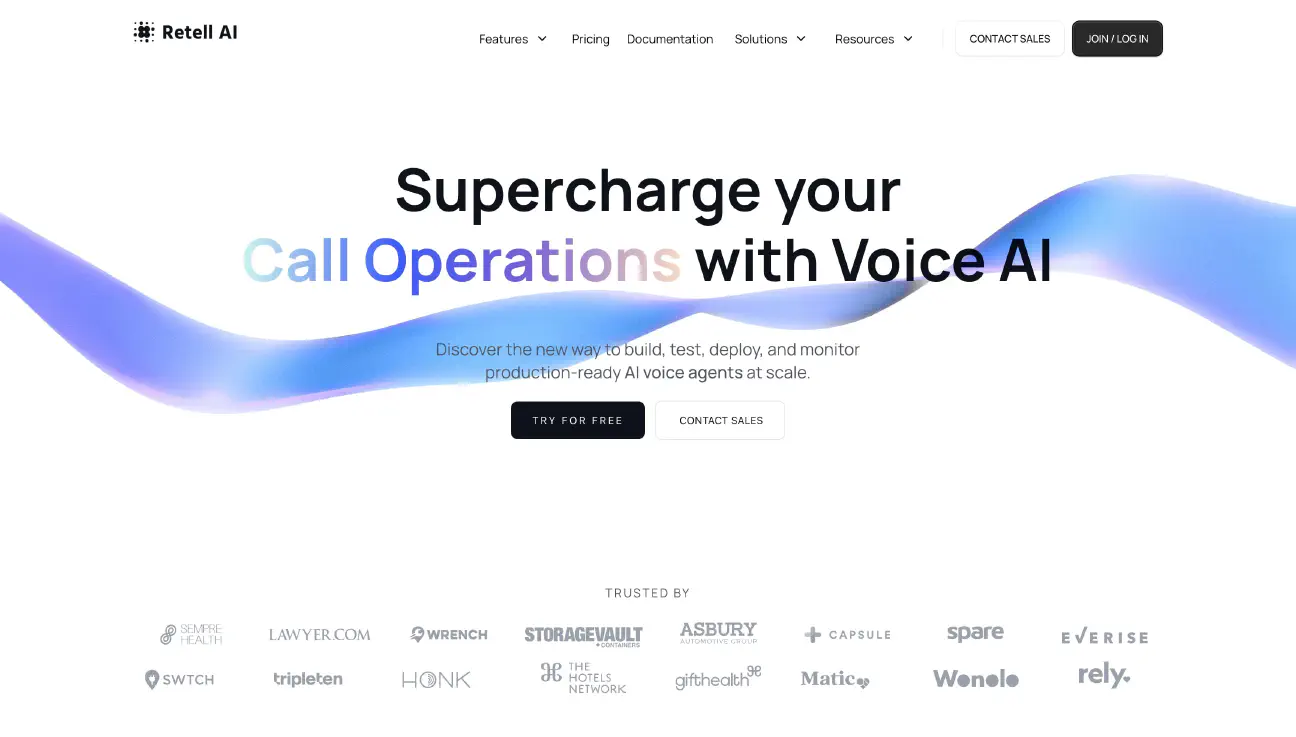
If you’ve been planning on using AI in healthcare marketing, sales or customer service, you might have seen Retell already. It’s a HIPAA-compliance ready platform with plenty of build-in guardrails and security features. Setting it up is straightforward. You feed it your website content, FAQs, or internal docs, and the agent pulls from that knowledge base in real time.
The conversation flow builder lets you add guardrails, so the agent doesn’t wander off track, a common risk with less structured tools. The real power shows up once the call ends. Retell generates detailed summaries, tracks sentiment, and flags whether tasks were completed (like an appointment booked or a payment collected). For teams running hundreds of calls, that visibility saves hours of manual review.
Of course, there are gaps that drive companies towards Retell AI competitors (like a lack of advanced voice cloning), but Retell still delivers some of the best AI voice agents around for some industries.
Key Features
- Knowledge base sync for real-time answers
- Conversation flow builder with fallback logic
- Batch calling and SIP trunk support for scaling
- Post-call summaries, sentiment analysis, and task tracking
- Warm transfers and IVR navigation
- HIPAA compliance ready
Pricing: You can start with $10 of free credits: $10 (about 60 minutes). After that, you’ll move onto a pay-as-you-go model, with prices ranging from $0.07–$0.31/minute
Pros
- Strong post-call analysis and reporting
- Guardrails reduce AI errors in live calls
- Scales easily for large outbound campaigns
- Works well in regulated industries
Cons
- Usage-based pricing can add up
- Choice of LLM may influence call costs
7. Cognigy: Best for Enterprise Contact Centers
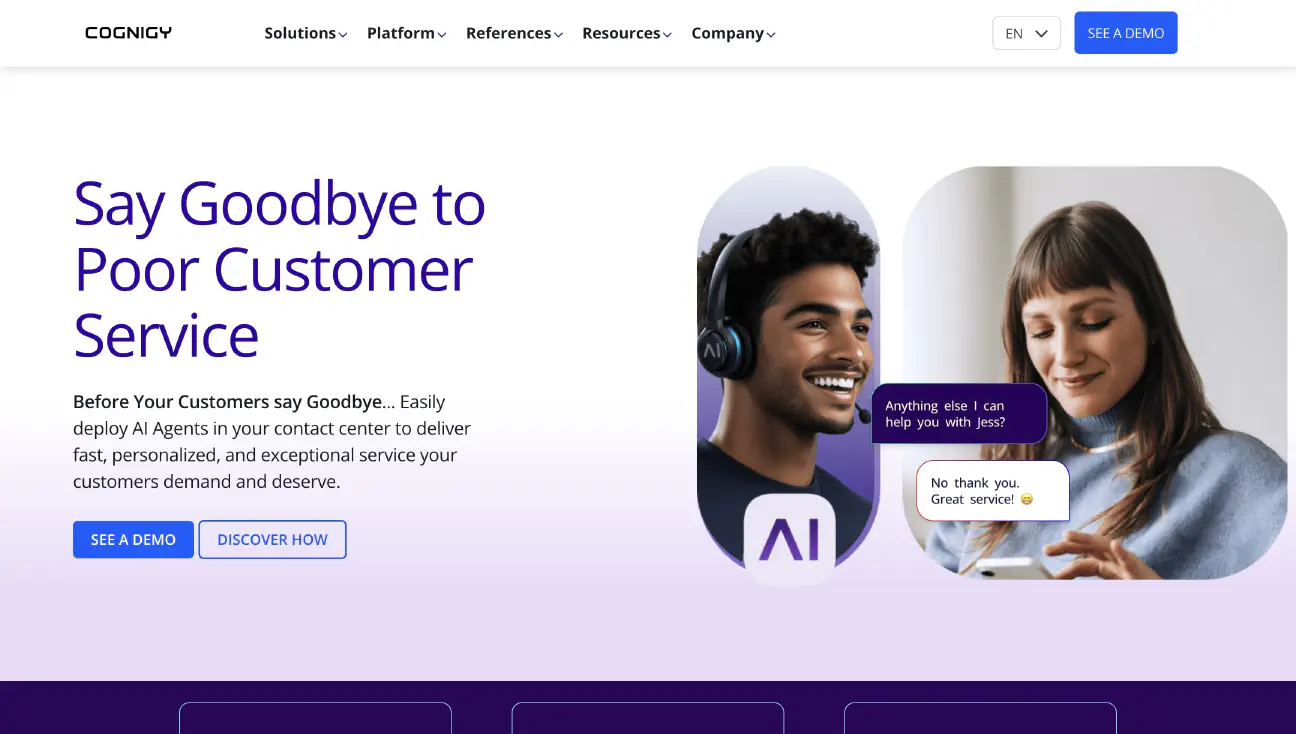
Enterprise contact centers have a different set of needs than small businesses. They need scale, resilience, and compliance baked in. Cognigy is built for exactly that. It’s less of a plug-and-play tool and more of a full AI platform designed to support global operations.
What stands out is the AI Agent Manager, a central hub where teams can design, deploy, and monitor agents at scale. There’s a visual builder were you can create entire workflows for conversational customer engagement, sales, and service. You can even add escalation paths, fallback scenarios, and proactive outbound calling.
While there’s a lot under the hood, the interface feels workable once you spend a little time with it. Cognigy also ships with a Voice Gateway that connects directly to systems like Genesys, Avaya, and Amazon Connect.
Key Features
- AI Agent Manager for building and monitoring at scale
- Visual flow builder with routing and escalation
- Cognigy Voice Gateway for direct telephony integration
- Enterprise-grade analytics with Cognigy Insights
- Compliance and security for regulated industries
Pricing: Custom enterprise pricing only (by quote)
Pros
- Built for complex, high-volume environments
- Strong integrations with enterprise telephony systems
- Deep analytics for tracking performance
- Visual builder makes complex flows manageable
Cons
- Steeper learning curve than lighter tools
- Requires IT involvement for setup and integration
8. VOCALLS: Best for Multichannel Automation
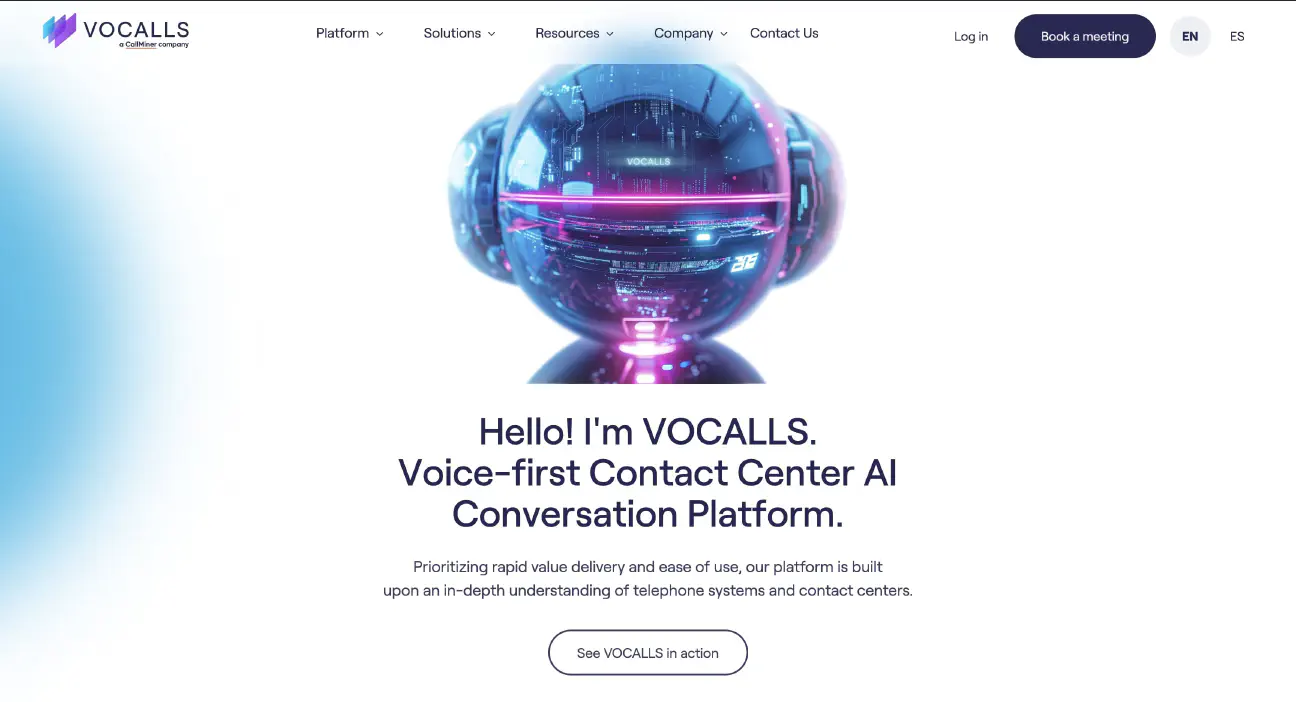
Some companies don’t just want voice agents. They need automation across every channel -phone, chat, and even email. That’s where VOCALLS comes in. It’s a conversational AI platform designed to spread the load, handling repetitive work wherever it shows up.
A big strength is its low-code designer, which lets teams build flows without starting from scratch. It also supports features like LiveTranslate, so conversations can switch languages midstream. For international businesses, that makes a real difference.
VOCALLS ties directly into systems like Salesforce, Zendesk, Twilio, and Microsoft Teams, so agents don’t live in a silo. If you’re exploring agentic AI vs conversational AI, Clerk Chat has more advanced features, but VOCALLS still works well for smaller companies.
Key Features
- Voice, chat, and email automation
- LiveTranslate for multilingual support
- Analytics dashboard with performance tracking
- Low-code flow builder
- Integrations with Salesforce, Zendesk, Twilio, and Teams
Pricing: Custom pricing by request
Pros
- Covers multiple channels, not just voice
- Built-in multilingual support
- Easy to design and adjust flows
- Works smoothly with major enterprise tools
Cons
- Pricing not transparent
- Not ideal for agentic AI in CX
9. PolyAI: Best for Multilingual Enterprises
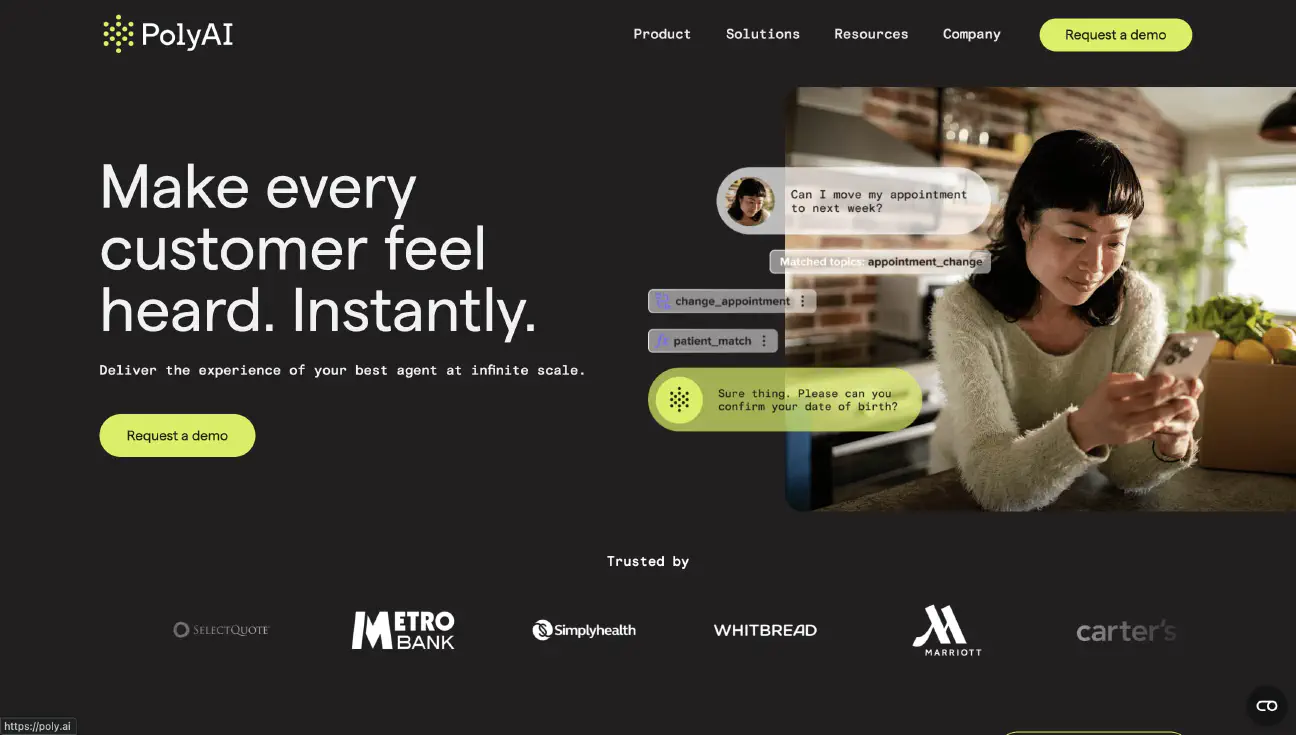
If your customers come from different countries, accents, and backgrounds, then multilingual support is essential. PolyAI offers some of the best AI voice agents built around that need. It creates voice agents that don’t just translate but understand nuance in how people actually speak.
This platform shows up a lot in comparison guides looking at Yellow.ai alternatives and similar solutions. It works especially well in enterprise contact centers. A caller in Spain can interact in Spanish, while a customer in India gets support in Hindi, all without a separate setup. Businesses can create branded AI personas, giving every interaction the same tone and identity.
The system integrates with platforms like Salesforce and Zendesk, and offers access controls and security measures, which is great if you’re exploring voice AI vendors for financial services or healthcare. The downside is it can get quite expensive.
Key Features
- Multilingual support across dozens of languages
- Customizable AI personas for brand voice
- Dialogue management for complex calls
- Reporting and analytics dashboards
- Integrations with Salesforce, Zendesk, Genesys, Amazon Connect, Cisco
Pricing: Enterprise pricing by request
Pros
- Excellent for large, multilingual contact centers
- Customizable voices and personas
- Strong integrations with enterprise systems
- Scales globally without patchwork solutions
Cons
- Requires enterprise budget and resources
- Not suited for small teams or startups
10. Deepgram: Best for Speech Recognition Accuracy
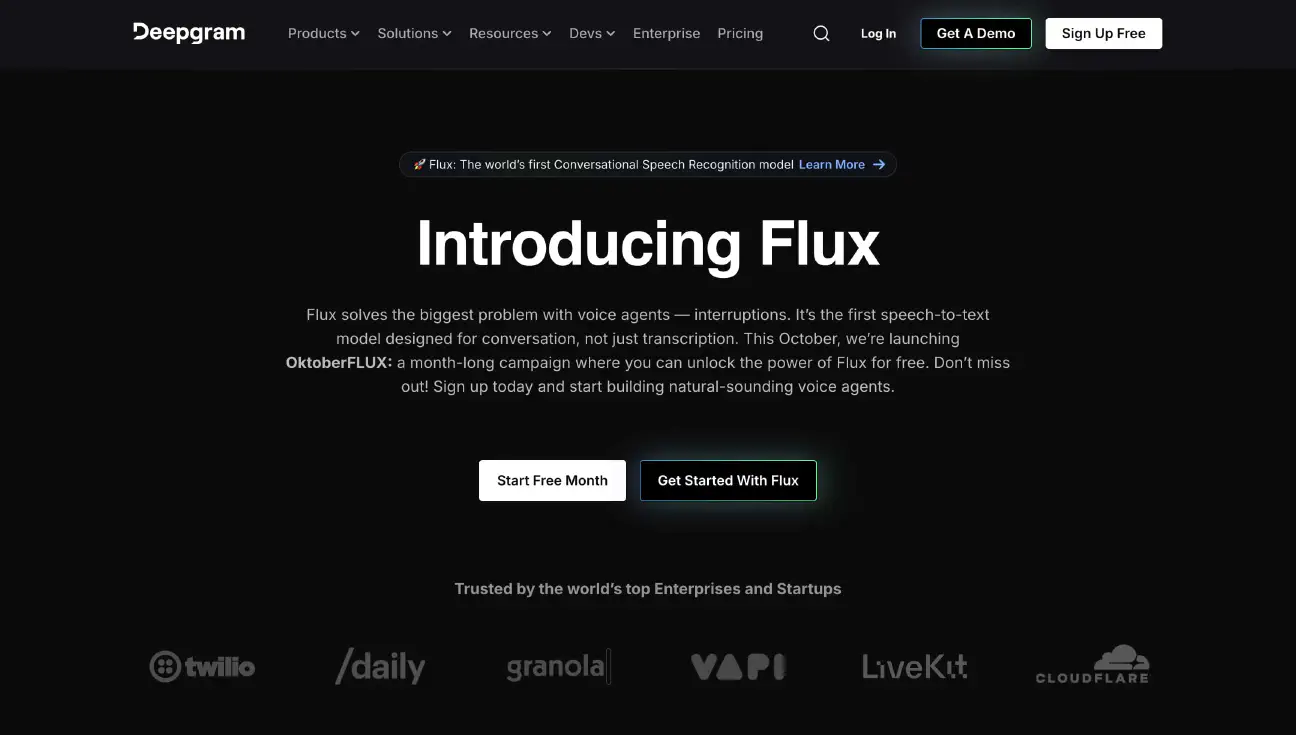
While many AI voice companies focus on using conversational AI in customer service to respond to callers, Deepgram specializes in listening. It’s a speech recognition engine built to turn spoken language into text with speed and accuracy - the foundation that other voice AI platforms can build on.
In noisy environments or with challenging accents, Deepgram consistently holds up. It offers domain-specific tuning, so a medical practice, for example, can train it to handle technical terms without constant errors. For call centers or support desks, that level of precision keeps workflows smooth.
Developers often pair Deepgram with platforms like Vapi or Twilio, streaming audio in real time and using the transcripts to drive responses. It doesn’t run the whole conversation itself, but as the “ears” of a system, it’s hard to beat.
Key Features
- High-accuracy, real-time speech recognition
- Low latency for live call handling
- Customizable models for industry-specific language
- Scales across large volumes of audio
- Easy integration with APIs and WebSockets
Pricing: You start with a free trial that includes $200 in credits. After that it’s pay-as-you-go, with rates from $0.004 per second - about twenty-four cents for a minute of audio.
Pros
- Extremely accurate, even in noisy conditions
- Real-time transcription with low latency
- Customizable for technical or niche vocabularies
- Scales for enterprise call volumes
Cons
- Only handles transcription, not conversation flow
- Costs can climb with heavy usage
11. ElevenLabs: Best for Expressive AI Voices
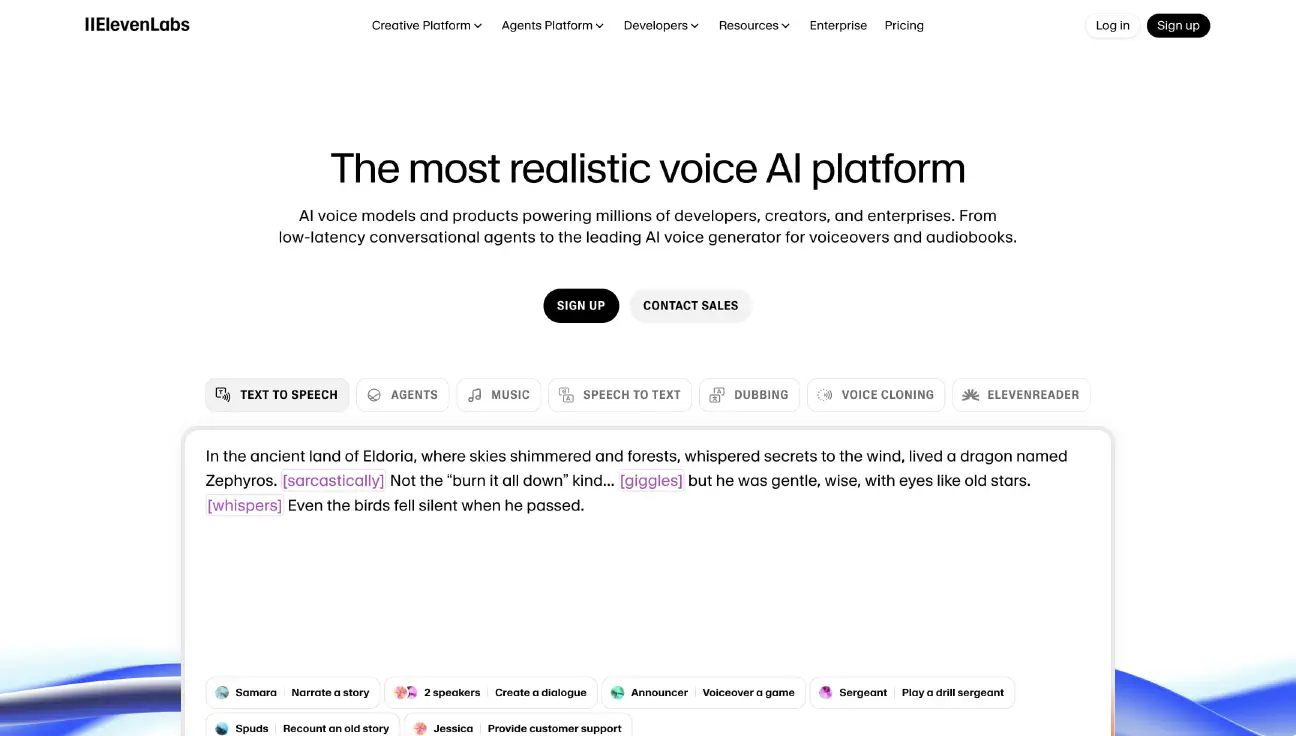
If you’ve ever listened to a text-to-speech tool and thought, “That sounds like a robot reading a script,” you’ll understand why ElevenLabs has become so popular for companies seeking the best AI voice agents. Its focus is on making voices sound truly human.
What makes ElevenLabs stand out is the range of expression in the voices. A voice agent can sound calm and steady on a support call, a little brighter for a sales follow-up, or more formal when walking someone through instructions. Even subtle things, a pause here, a lift in tone there, make conversations feel less mechanical.
It also supports voice cloning, which means a company can create a single “brand voice” and use it everywhere, from onboarding to outbound sales. For international teams, the library of accents and languages helps customers feel at ease no matter where they are.
Key Features
- Expressive, human-like voice generation
- Emotional tone adjustments through natural phrasing
- Voice cloning for brand consistency
- Supports dozens of languages and accents
- Works with third-party platforms for full automation
Pricing: There’s a free plan with basic voice generation. Paid plans start at $5 per month for light personal use, or $22 for the Creator plan.
Pros
- Most natural and expressive voices available today
- Wide support for languages and accents
- Customizable voices that match brand identity
- Integrates easily with other platforms
Cons
- Doesn’t manage call flows or routing
- Costs rise quickly with heavy usage
- Requires pairing with another voice AI platform
Challenges of Deploying Voice AI Platforms
Rolling out the best AI voice agents is rarely as simple as clicking “on.” The technology works, but real-world use surfaces challenges that aren’t obvious in a demo. Here are four big ones to watch for:
1. Setup and Integration
There’s a big difference between deploying conversational AI vs chatbots. Most modern tools lean on an API-first setup. That gives flexibility, but it can also overwhelm smaller teams. Even a no-code builder takes trial and error to get the conversation flow right. Connecting to a CRM or ticketing system early helps avoid silos. Start small. Build one call flow, test it, then expand.
2. Voice Quality and Timing
People can spot hesitation straight away. If the response lags or the tone sounds off, the whole thing feels robotic. And if the speech recognition struggles in a noisy room or with a different accent, it only gets worse. Don’t just trust the demo. Try it out with actual customers and see how it holds up.
3. Data Security and Compliance
You’ll already know how challenging data security and compliance can be if you’ve tried adding AI to healthcare text messaging communication, or financial workflows. When you start experimenting with the best voice AI agents, the risks can increase. Mishandling call summaries or personal data isn’t just inconvenient, it’s risky. Vendors should be able to show proof of compliance with HIPAA, GDPR, and SOC2.
4. Adoption Across Teams
If a system feels like extra work, staff won’t use it. It has to tie into CRMs, offer clear sentiment tracking, and produce transcripts people actually trust. Otherwise, adoption fizzles out fast. Roll out in phases, train your employees, and show quick wins so teams see the value early.
Future Trends Shaping AI Voice Companies
The voice agent market isn’t slowing down. In fact, it feels like the opposite. New AI voice companies are raising rounds of funding, releasing tools, and competing hard for space in customer service, healthcare, and finance. A few trends are already shaping where things are heading next.
- The Shift from Conversational to Agentic: Early tools were mainly about dialogue - chatbots with voices. The next wave is about action. Modern platforms combine natural language processing (NLP) with integrations that trigger tasks in real time. The result: agents that don’t just talk, they do. Scheduling, updating records, or escalating a case - all without human handoff.
- Better Voices, Better Fit: Expect rapid gains in speech recognition and real-time speech recognition accuracy. At the same time, tools like voice cloning and customizable voice styles are making agents feel more human and more on-brand. Small touches, like improved emotional inflection, change how authentic a conversation feels.
- Deeper Customization: Platforms are moving toward customizable models and modular designs. Whether through a full API-first setup or a guided conversation flow builder, companies can now design agents that reflect industry-specific language and compliance needs. An AI agent manager or dashboard helps teams monitor and adjust these flows.
- Industry specific systems: Just as we have dedicated finance text messaging software and healthcare contact center systems, we’ll soon have voice agents built for specific industries. That matters as compliance risks continue to grow.
- Integration as the Differentiator: The future winners will be those that connect smoothly into existing ecosystems: call centers, text messaging systems, CRMs, telephony, and support desks. The “voice wedge” strategy is already in play: start with one task, then expand quickly across workflows.
The Best Voice AI Agents in 2025
Voice AI isn’t experimental anymore - it’s part of day-to-day operations. Small clinics are using it. So are big contact centers. The best AI voice agents are now baked into customer service, sales, and back-office work. The upside is obvious: customers get faster answers, teams move through tasks with less friction, and repetitive jobs stop eating up whole days.
Each platform we’ve reviewed brings something different. Lindy is ideal for teams without developers. Vapi gives engineers full control with its API-first setup. Retell AI shines in healthcare and compliance-heavy sectors. PolyAI handles global, multilingual service with ease. And ElevenLabs brings unmatched expression to the voices themselves.
But one platform stands out overall: Clerk Chat. Its strength is flexibility. By pulling calls, texts, and messaging apps into one place, it solves a real problem most businesses face - customers don’t stick to a single channel. With Clerk Chat, you can run voice agents alongside SMS or WhatsApp, keep records updated in your CRM, and even automate support tickets or reminders. It works for small teams just starting with automation, and it scales into bigger B2B use cases without forcing a rebuild.
The truth is, the “best” choice will always depend on your context - your customers, your industry, your team. But if you’re looking for a platform that balances usability, integration, and reach, Clerk Chat is the one to beat.
Will’s latest superpower is building innovative AI solutions to add value for clients. He's passionate about all things AI, entrepreneurship, and enjoys staying active with sports and outdoor activities.
In this article:
- Understanding the Value of AI Voice Agents
- The Use Cases for Voice AI Platforms and Agents
- Comparing the Best Voice AI Agents: What to Consider
- The Best AI Voice Agents in 2025: Comparing Platforms
- Challenges of Deploying Voice AI Platforms
- Future Trends Shaping AI Voice Companies
- The Best Voice AI Agents in 2025
Ready to use your business number for text messaging?
Thousands of businesses are already experiencing the power of conversational messaging through SMS. Join us. Free trial and paid tiers available.
Get Started#Subscribe
Get product updates in your inbox
Tutorials, features, and Clerk Chat news delivered straight to you.
